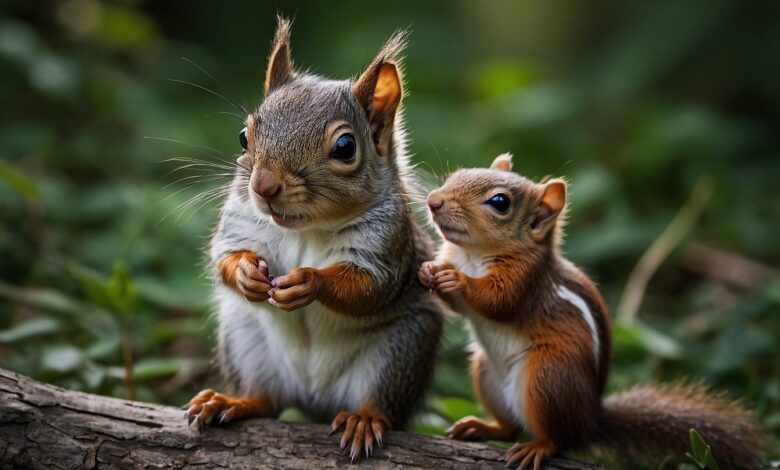The Ultimate Baby Squirrel Age Guide: From Surviving to Thriving
From Infancy: A Comprehensive Baby Squirrel Age Guide

Introduction To
Baby Squirrel Age Guide
Bringing up a baby squirrel requires careful attention and dedication. Understanding the importance of proper baby squirrel care is crucial for their well-being. This guide will take you through the various stages of a baby squirrel’s life, help you determine their age accurately, and provide you with valuable insights on how to care for them at each phase.
I. First Weeks: Newborn Phase
During the first weeks of a baby squirrel’s life, they are incredibly fragile and dependent on their caregivers. Consider these vital factors during this phase: Characteristics of Newborn Baby Squirrels:
Newborn baby squirrels are completely hairless and have their eyes and ears sealed shut. They are also highly sensitive to light and sudden movements. Their tiny size and helplessness make them vulnerable, so it’s crucial to provide a safe and nurturing habitat.
- Creating a Safe and Nurturing Habitat:
Ensure the habitat is warm, quiet, and free from any potential hazards. Provide soft bedding and a comfortable nesting area that mimics the natural environment. Maintaining a controlled temperature and humidity level is vital for their survival. - Feeding Techniques for Newborns:
Newborn squirrels require specialized care when it comes to feeding. Using a syringe or dropper, provide them with a milk replacement formula specifically designed for baby squirrels. It’s essential to feed them at regular intervals and in small amounts to prevent overfeeding or choking. - Overcoming Common Challenges:
As with any newborn, baby squirrels may face challenges such as weak immune systems, dehydration, or difficulty in eliminating waste. Monitoring their health closely and seeking professional veterinary assistance when needed is crucial for their survival during this delicate phase.
II. Eyes Open: Eyes and Ears Unveiled
As baby squirrels reach this stage, their senses begin to develop. It’s an exciting time as they start exploring the world around them. Here’s what you should consider:
- The Development of Senses in Baby Squirrels:
With their eyes and ears opening, baby squirrels can perceive their surroundings more effectively. They become curious and start responding to visual and auditory stimuli. Encouraging exploration and play is important for their mental stimulation and growth. - Encouraging Exploration and Play:
Provide a safe and supervised environment where baby squirrels can explore their surroundings. Offer them toys, branches, and objects they can investigate, promoting their instincts in a controlled setting. - Solidifying Bonding Opportunities:
During this phase, bonding with the baby squirrels becomes crucial. Spend time interacting with them gently, using slow and calm movements. This helps them feel secure and builds trust, strengthening the bond between human caregivers and baby squirrels.
III. Teething Troubles: Transition to Solids
Teething can be a challenging phase for baby squirrels. Knowing how to navigate it properly will contribute to their healthy growth and development. Consider the following:
- Signs of Teething in Baby Squirrels:
As baby squirrels start teething, they may exhibit behaviors such as chewing on objects excessively or rubbing their gums. Providing appropriate teething toys, such as safe wooden blocks, can help alleviate discomfort. - Introduction to Solid Foods:
Introduce solid foods gradually, starting with soft fruits and vegetables. It’s important to ensure the food is easily digestible and free of pesticides. This transition helps them develop their jaw strength and adapt to a varied diet. - Nutritious Diet for Optimal Growth:
To support their optimal growth, provide a balanced diet consisting of fresh fruits, vegetables, and high-quality nuts. This ensures they receive essential vitamins, minerals, and proteins necessary for their development. - Strategies for Ensuring Adequate Hydration:
Proper hydration is vital for baby squirrels. Offer them fresh water in a shallow dish, ensuring it is easily accessible. Additionally, consider providing them with hydration-rich foods like cucumbers or melons.
IV. Fur and Freedom: Gearing Up for Independence
As baby squirrels grow, they begin to develop fur and gain more physical abilities. This phase prepares them for a more independent lifestyle. Here’s what you need to know:
- The Emergence of Fur and Physical Progress:
Gradually, baby squirrels develop their fur, becoming less reliant on external heat sources. Alongside this, their physical capabilities, such as coordination and balance, start to improve. Observe their progress and encourage their movement and climbing skills. - Encouraging Independent Movement and Climbing Skills:
Providing an environment that supports their physical development is crucial. Offer branches and platforms for climbing and play. This helps promote their natural agility and prepares them for life in the wild. - Introducing Environmental Enrichment:
Stimulate their minds and instincts by introducing various environmental enrichments. This can include natural materials like leaves and twigs, puzzle feeders, or hiding treats for them to forage. Such activities enhance their problem-solving abilities and keep them mentally engaged.
V. Social Butterflies: Socialization and Interaction
Baby squirrels thrive in a social environment. Encouraging socialization and providing opportunities for interaction is vital for their overall well-being. Consider the following:
- The Importance of Socialization for Baby Squirrels:
Socialization plays a crucial role in the development of baby squirrels. It helps them learn vital communication and survival skills. Introduce them to other squirrels of the same age in a controlled and supervised setting. - Proper Handling Techniques and Interaction Guidelines:
When handling baby squirrels, always use gentle and calm motions. Avoid sudden movements that may startle them. Allow them to approach you at their own pace, creating a sense of trust and security. - Opportunities for Communication and Bonding:
Spend time interacting with baby squirrels through gentle touch and soft vocalizations. This helps them develop a sense of trust and encourages healthy bonding. Avoid excessive handling to prevent stress and support their instincts.
VI. Adolescent Challenges: Navigating Growth Spurts
Just like human adolescents, baby squirrels go through growth spurts and behavioral changes. Being aware of these challenges will help you provide appropriate care. Consider the following:
- Understanding Puberty in Baby Squirrels:
During adolescence, baby squirrels may experience hormonal changes that can result in increased energy, restlessness, and challenging behavior. In navigating this phase, it’s crucial to maintain patience and understanding. Adjusting Diet and Exercise Regimens:
To accommodate their rapid growth, it is necessary to adjust their diet accordingly. Provide sufficient protein-rich foods, such as insects or nuts, to support their developing bodies. Additionally, offers ample opportunities for exercise and play. - Handling Behavioral Changes and Challenges:
Some adolescent squirrels may become more territorial or exhibit aggression. Consistency in their care and socialization can help them overcome these challenges. Seek guidance from professionals if the behavior becomes concerning.
VII. Preparing for the Wild: Self-Sufficiency Transition
As baby squirrels near adulthood, preparing them for life in the wild is essential. Gradually transitioning them to natural foods and environments is crucial. Consider the following:
- Emphasising Survival Skills:
Expose baby squirrels to natural elements, such as outdoor sounds or scents, to help them acclimate to their future habitats. Encourage them to forage for food by providing hiding spots with nuts or seeds. - Gradually Introducing Natural Foods:
Slowly reduce the reliance on human-provided foods and transition them to a diet that reflects their natural foraging habits. Provide a variety of nuts, seeds, and fruits that are commonly found in their environment. - Pre-Release Preparation and Techniques:
Before releasing a baby squirrel into the wild, ensure they have the necessary survival skills. Gradually increase their exposure to the outside world, allowing them to explore while still providing a safe sanctuary to return to. - Ensuring a Safe Release:
Choose a suitable release location that offers appropriate food sources, shelter, and natural predators. Monitor the squirrel’s progress in the wild and intervene only if necessary.
VIII. Summary: Nurturing Baby Squirrel Age Guide through Every Stage
Caring for baby squirrels is a rewarding journey that requires dedication and patience. In brief, remember the following key points: Recapitulating the Key Developmental Milestones:
Understanding the different stages of a baby squirrel’s life is crucial for their well-being. From the newborn phase to adolescence, each stage brings unique challenges and joys.
- Emphasising the Essential Role of Human Care:
Human caregivers play a vital role in providing the necessary care and support for baby squirrels. Be attentive, responsive, and sensitive to their needs throughout all stages of development. - Celebrating the Journey of Baby Squirrels:
Nurturing baby squirrels from their vulnerable beginnings to self-sufficient individuals is a remarkable experience. Cherish the process and the unique bond that forms between you and these incredible creatures.
X. FAQs (Baby Squirrel Age Guide)
Here are some common questions related to baby squirrel age guide care:
- How do you determine a baby squirrel’s age without their mother?
Determining a baby squirrel’s age without the mother can be challenging. However, you can observe their physical characteristics, such as fur development or eye-opening, along with their behavioural milestones to estimate their age. - What foods should I feed a newborn baby squirrel?
Newborn baby squirrels should be fed a specialised milk replacement formula designed for their nutritional needs. Consult a veterinarian or wildlife rehabilitator for specific guidance. - Is it permissible to raise a baby squirrel as a pet?
- In many places, it is illegal to keep a baby squirrel as a pet without the necessary permits. Additionally, baby squirrels have specific needs and require specialised care that may be difficult for most people to provide.
- How can I ensure the squirrel’s survival during its transition to independence?
Ensure their environment is suitable, provide a balanced diet, and gradually introduce natural elements. Monitoring their progress and seeking professional advice when needed will help ensure their successful transition to independence.






